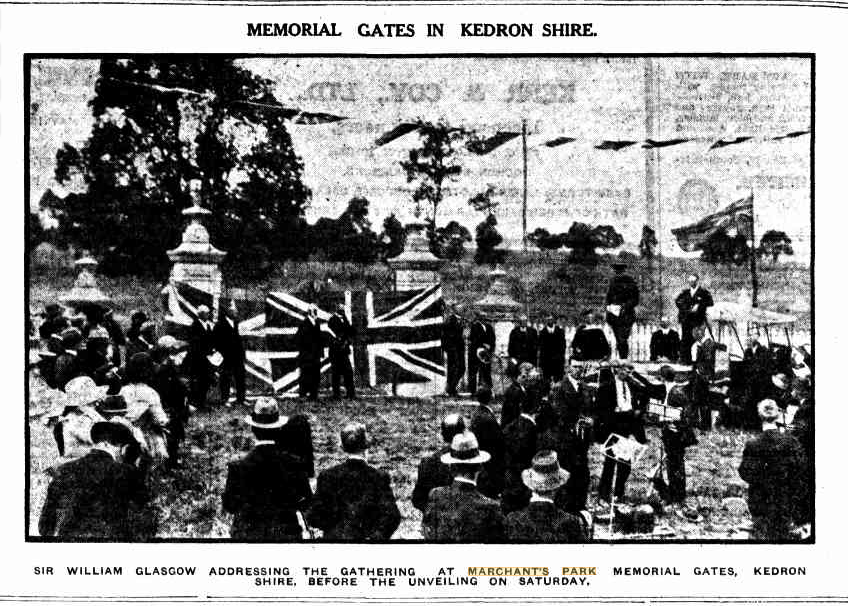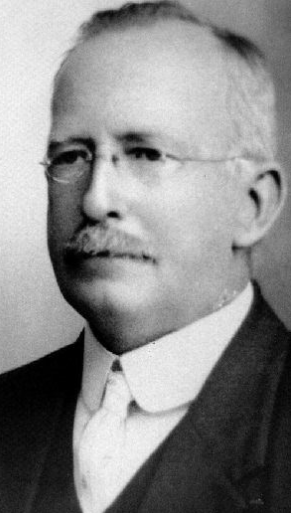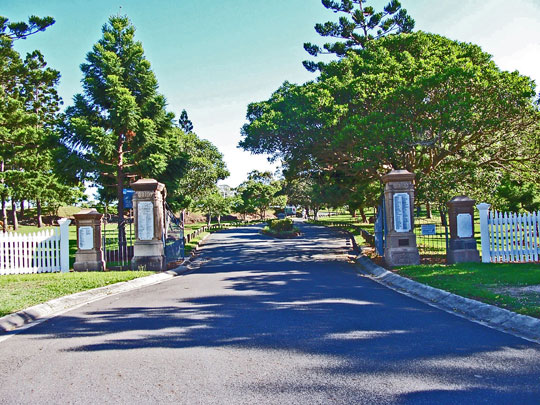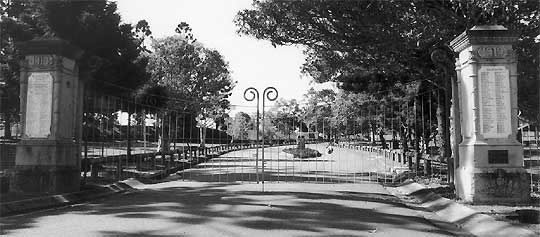Chermside & Districts Historical Society
Marchant Park
Originally written by Pat O’Shea, 2010. Updated by Sherry Mackay, Julia van Zon, Bradley Scott, 2023.
History of the Memorial Gates
On August 24, 1899, George and Mary Marchant, wealthy soft drink manufacturers, bought the portion of Murphy’s Paddock bounded by Ellison, Murphy and Gympie Roads, a parcel of forty hectares that is today’s Marchant Park.
On January 4, 1916, the Kedron Central Progress Association asked the Kedron Shire Council to establish ‘Memorial Tablets’ to enlisted soldiers. Just what they had in mind is not stated, but it may have been something like the actual gates. (NB: There was no Brisbane City Council until 1925.)
On March 20, 1917, George and Mary Marchant made an approach to donate the land as a gift to the Shire for use as a park, but the Council hesitated because it would lose revenue on rates.
By July 6, 1920, the Kedron Shire War Memorial Committee sent a deputation to the Council to discuss the inability to build a war memorial. Public meetings had been held and the Council may have agreed to work with the Committee. This is not clear.
On September 7, 1920, the Kedron War Memorial Committee wrote to the Council asking permission to build the soldiers’ memorial in what became Marchant Park. They also recommended that Council peg out roads in the park. Council deferred any decision. A deputation (of the Committee?) then went to the Home Secretary to get help. The result was the Home Secretary told the Council it must acquire the park.
Then on September 9, 1921, the Marchants gave the land to Kedron Shire Council for use as a park. Part of the deal was that the Council relocate August Vellnagel’s four acre (1.6 Ha) forge site from the present gate area across to the other side of Gympie Road opposite Murphy Road. This was to make the entire area available for development as a park. The forge continued working on the other side of Gympie Road till 2004 under the name of Vellnagel Brothers when they sold out and moved to Brendale. As of 2016 the firm is still operated by the family, now into the fourth and fifth generation.

Sir William Glasgow addressing the gathering at Marchant’s Park Memorial Gates, Kedron Shire, before the unveiling on Saturday.

George Marchant
Construction of the Gates

Originally the gates were designed for the transport vehicles of the time which were smaller than in the 1970s. Hence the gates were smaller than the current ones. The finials were still in place, and all that remains today are the holes into which they fitted. They were most likely made of metal, maybe bronze? Photo courtesy of the Vellnagel Family.

Recent image of Marchant Park gates.
The construction of the gates was possibly started at the beginning of 1924 as the opening was in May of that year. According to Merv Royle, the monumental mason who carved the names (and erected the gate posts?) was probably Frank E. Ives who had his yard at the edge of the Lutwyche Cemetery on Gympie Rd.
A Facebook reader recently informed us that a Stan Ives was operating the business in the 1960s. The site as of 2016, is occupied by a Veterinary Clinic.
The sandstone gateposts would have been much the same as they are now, but with sandstone blocks about 180mm (7 inches) thick on top of each post. These possibly acted as some sort of base for finials. The early photo of the gates shows the finials as being substantial objects.Eight marble plaques were secured on the sandstone gate posts. Harold Vellnagel describes the earlier gates as “old iron” (possibly a trade name for wrought iron) which did not rust easily and was good for forge welding. These gates were riveted together not welded as are the present ones. On each leaf there was a small wheel running on an iron track. It supported the weight of the leaf, which was hinged to the stone gatepost at the other end. A photo taken in the 1970 shows that the gates were missing, but were described as “decorative wrought iron, the main ones being flanked with small pedestrian gates”.
There were eight marble plaques about 20mm thick – four are large ones on the two main gateposts and four are small plaques on the smaller gateposts. The plaques were screwed on to the sandstone gateposts. The four large plaques were inscribed and one of the small ones was used for the names of South African veterans. The other three small plaques were blank. Merv Royle believes that some of the money for the gates could have come from the Patriotic Fund, which was raised locally to help the war effort.
Dedication and opening of the Gates
On the 5th May 1924, the Brisbane Courier recorded the opening of the Gates on the previous Saturday 3rd May:
A WAR MEMORIAL
KEDRON’S TRIBUTE OPENED.
General Sir William Glasgow opened the War Memorial gates at Marchant Park, Kedron, on Saturday, in the presence of a large gathering. Mr. D. S. J. Barker presided, and, in introducing General Glasgow, stated that of the £475 required for the erection of the gates and the tablets upon them, £445 had been subscribed by the public, and £30 had been donated by the Council. (In 2003 values, this would be about $25,500.) The tablets contained the names of 273 men who had enlisted from the district. Of these 52 (53 on the tablet) were killed. (The fully restored tablets have 284 names).
In opening the gates and unveiling the tablets, General Glasgow stated that he knew the district well for a strongly patriotic place. As a trooper in the mounted infantry long ago, he had served in Kedron, and many happy memories had he of it (sic). Mr. W. Kelso, M.L.A., and Councillor Marquis also spoke. The Rev. S. Macdonald delivered an address, and the hymn, “O God Our Help in Ages Past” was sung.
Major General Sir Thomas William Glasgow (CB, DSO, CMG) (1876-1955), 2nd Light Horse, was a distinguished soldier who fought in the South African War and the Great War. He came from the Maryborough area and was a trooper in the Queensland Mounted Infantry before going to South Africa. He entered the Australian Senate after WWI and served as a Cabinet Minister for many years. At the outbreak of WWII he was appointed High Commissioner to Canada, returning to Australia in 1945.

The Brochure printed for the dedication ceremony of the Kedron War Memorial on Saturday, 3rd May 1924 at Marchant Park, Chermside. The brochure belonged to Vivian Heiner who, at age four years, was present with her father, Councillor Marquis, at the ceremony. Viv was a long-time member of the CDHS and never missed a meeting even when she was in a wheel chair. Viv died in 2012 aged 92. Councillor Marquis “Expressed Thanks” to General Glasgow for opening the gates.
Vandals destroy the tablets

The heavy, iron gate is clearly shown attached to the stone post. The weight was offset by a curved rail on which ran a small wheel attached to the gate leaf. This photo has a stark quality about it which enhances the vileness of the destruction. It also shows that the gates have been neglected as the iron gate leaf is immobilised by the dirt and rubbish on the ground.
In 1972 the plaques were vandalised. Dr Jack Ford found a report of the damage in the Courier Mail of 18 March 1972, page 3. Of the eight white marble plaques, six had to be replaced. The older, more weather-worn plaques are screwed onto the sandstone gateposts but the new smoother ones are held by concealed bolts.
Photo of Marchant Park gates taken with a Polaroid camera from the South or outside of the gates shows some of the damage. It shows that the small plaque on the Gympie Road (West) post is intact but damaged with a triangular piece broken out of one side. Moving to the east (away from Gympie Road) the fallen soldiers’ plaque is undamaged on the next large post.
The second large post has no plaque at all but shows the four holes that once held a plaque. The final small post on the eastern side has a blank plaque screwed on to the post. In all, three large and three small plaques were destroyed and replaced.
Some 131 of the names were recovered and inscribed in alphabetical order on the two new plaques on the inside of the gates (North side), but there was a large gap between the names Fox and North.
This restoration was probably done by the Brisbane City Council.
Search for the missing names
On 25th March 1996, I contacted the Australian War Memorial in Canberra and then the John Oxley Library, the Australian Archives, the City Council Archives and the local RSL Sub-branches, but to no avail. It seemed the research had run up a dead end. I contacted various residents and received information, which when followed up generally led nowhere as the old records either no longer existed or could not be found. NB: these records (Honour Rolls) may well exist but have yet to be located. Terry Sullivan supplied a map of the old Kedron Shire, and David Teague also helped with information.
Finally, on 15th October 1998, I wrote a letter to the Quest Newspapers group which drew several replies with information:
• Kath Ballard directed me to the Zillmere School of Arts Honour Roll at Zillmere Library.
• Hugh Carseldine directed me to the Honour Roll at Bald Hills Memorial Hall.
The above Honour Rolls along with the Marchant Park Gates and the Banyo Memorial Hall list were photographed. The Banyo list was discarded as it was outside the boundary of Kedron Shire. The names were then listed separately and compared. All the dead listed on the Zillmere and Bald Hills lists appeared on the Marchant Park Gates list of fallen. All other names on these lists, which did not appear on the Marchant Park lists apart from the dead, were added to a separate list.
• Relatives who answered my letter to the local paper supplied three names while others supplied information about diggers already on the gates;
• Jim Whelan (8/3/99) found several Honour Rolls in storerooms at the Kedron-Wavell RSL. The most important one was from the Chermside State School of which half the names were already on the gates. I included the remaining names since the diggers originally came from the area although they may have enlisted in other places;
• The final list of names came from the Research Officer of the Society, Beverley Isdale, who was researching the old Kedron Shire Council Minutes.

WWI Honour Board Chermside State School Before Restoration – The Honour Roll for Chermside is on the gates at Marchant Park which covered the whole of the Kedron Shire. When the marble tablets were smashed there was no other record. Then this sorry-looking relic was found in a store room at Kedron-Wavell RSL Sub Branch; it was a mess but we were delighted to find it. This was a valuable addition to our growing list of names, and most importantly, the only mention of Nurse Alice Mabel Cock.

Zillmere Honour Board – This large Honour Board was made for the Zillmere School of Arts and, presumably remained there until the building was demolished to make way for the Zillmere Library. This was done when the Brisbane City Council was taking over the local community-run libraries. The BCC built the then-new Chermside Library in 1958, so Zillmere was probably built around that time. The Honour Board was transferred to the new library and is prominently displayed. Consequently, it is seen by a large number of people the whole year round.

Bald Hills Honour Board – The Bald Hills Honour Board was displayed in the Bald Hills Memorial Hall, opened on 21st August 1920, after the Great War as part of the remembrance of the men who served. While it is in a prominent position in the hall, it is only seen by people when present at some function in the hall. The hall was a wooden building situated near the commercial centre of Bald Hills and like many 95-year-old wooden buildings was badly burnt in a fire on the morning of 18th November 2015. The Honour Board was damaged in the blaze and the committee which is seeking to rebuild asked the CDHS Inc. for help to restore it. We were able to give them copies of the photos taken in 2002 when we were researching this topic.

After restoration – Fortunately for the CDHS Inc. we had a sign-writer in the Society – 90 year old Adrian Turner, who set to work and produced this Board. Adrian was also a Master of Arts from the University of Queensland, and an accomplished artist. It now hangs on the wall of the meeting room of the CDHS Inc. building, which is the fully restored Chermside State School building in the Chermside Historical Precinct, Kittyhawk Drive, Chermside.
Listing the names alphabetically

The next step was to alphabetically list all the names from all the above sources to show up the repetitions and eliminate them. This would have been straightforward if all the names were listed accurately on all rolls; in reality it often becomes a matter of judgement in deciding if I am looking at one person listed as two different persons on separate rolls, or the same person listed differently on different rolls. Sometimes it was impossible to decide which way to go so, when in doubt, I listed both rather than leave somebody out.
The list amounted to some 480 names, but was finally narrowed down to 100 names, which when added to the existing ones totalled 284 names.
It is noteworthy that only one female is listed as such, and she came from the Chermside State School roll. Miss A. Cock was a nurse in the war. While Nurses were listed on the WWI Nominal Rolls there were none on the local Honour Rolls; maybe Nurse Cock was the only one in the local area to serve overseas.
Two plaques survived the vandals
This must rank as one of the worst acts of vandalism ever to have taken place in the local area. Whoever they were, they went to work with determination and all but wrecked the Memorial. Only two plaques survived.
The vandals must have come with the aim of wrecking the plaques, as they would need tools to smash the marble. They probably used hammers and or wedge-shaped levers, or maybe they used pieces of stone. The work would not have been easy and it took time to destroy six marble plaques. Why spare these two? Maybe they were disturbed and fled, or maybe they just got tired.


Two plaques restored - dates unknown

These plaques were probably restored by the Brisbane City Council, maybe when the gates were widened to allow easier use by larger vehicles such as buses.
I suspect the restoration was done by first finding the names on the pieces of marble which were legible. They did not know about the Memorial Boards which were in Zillmere and Bald Hills. To miss up to 100 names means that the pieces of marble must have been smashed very finely.
The restoration of the names probably followed the widening of the gates which could be done more easily without the marble plaques in place. I think that all this work took place in the 1970s because our family did not arrive in Brisbane until 1979, and soon after that I was riding through the park. I am sure I would have noticed if the Gates were being altered.

Two plaques restored in 2002 by CDHS
So finally the plaques are completed, fixed in place and re-dedicated to the memory of all those young men and one woman.
They went – young, healthy, full of hope, a hundred years ago and most returned but they were very different people. They did not talk about it until the 1970s when their diaries were being published. So we must honour their memory and their deeds, and work to try and prevent war from happening again. Hopeless? Maybe, but we must try by starting with ourselves and the way we treat others.



Dedication – The restoration work was carried out by Monumental & Masonry Supplies, 462 Newman Road, Geebung 4034. The rededication of the gates was carried out before about 100 guests on Saturday morning August 30 2003, followed by morning tea in Marchant Park.
